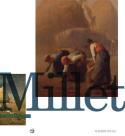Millet
Collective work
In 1889, a ‘road-show’ attracted crowds in the USA. In each town it went to tens of thousands of persons followed the convoy. Was it Buffalo Bill? Or a star from the music hall? The last Indian Chief or the winner of the Civil War? None of those. It was a simple painting, one single painting, the most famous of the times: the Angelus by Millet, which a group of American amateurs had just brought from France for the fabulous amount of 553 000 francs. A few years later, Chauchard, the owner of the Louvre department store, bought it back for 800 000 francs, the equivalent of various millions of our euros today. The purchase was then saluted as a patriotic gesture. Today, Jean-François Millet (1814-1875) is greatly ignored, and his last, wide retrospective in France dates back to 1973. This painting alone has remained an icon. But a new exhibition in Lille (at the Palais des Beaux-Arts, until 22 January 2018) intends to peal off the veil of neglect to remind the public of the extraordinary approach the painter had of the peasant life. The task is bestowed to an original catalogue, in a square shape, made up of two volumes glued to one another, under one same cover. The first volume runs through the painter’s life – a native of the Cotentin region on the Western part of Normandy - his self-portraits, his rare nudes, but especially his Winnowers, his Sawyers, his Shepherdesses, his Gardeuses d’oies and his Gleaners, scattered throughout the world, from Cincinnati to Cardiff, from Tokyo to Williamstown. The second volume reminiscences his surprising posterity in the USA, which has never waned, his influence on painting (Edward Hopper), on documentary photography (Lewis Hine, Dorothea Lange, Walker Evans) and, above all, on movies: Roman Polanski, Gus van San and Terence Malick are great amateurs of his art which openly inspires them. A French artist, a contemporary of Millet, Jules Breton, gave a brilliant explanation of his aura: “He can take a rough field in which lies a cart, a field sparsely covered with thistle, and with two or three tones and a careless and wooly technique, he can move you to the deepest depths of your soul and sing the infinity.” Although the founding event of 1889 is barely mentioned, it is a useful companion for lovers of Millet.
|  |
Review published in the newsletter #487 - from 19 October 2017 to 25 October 2017
